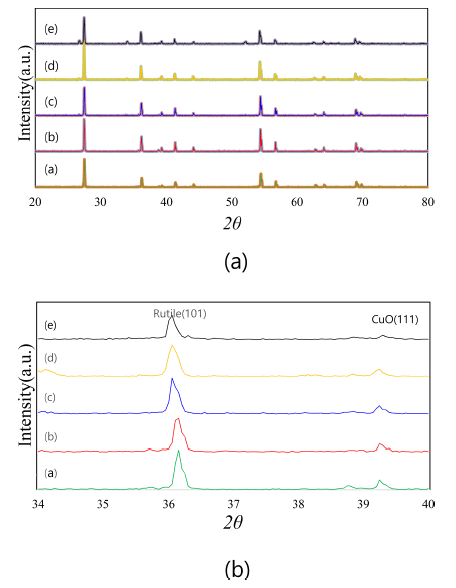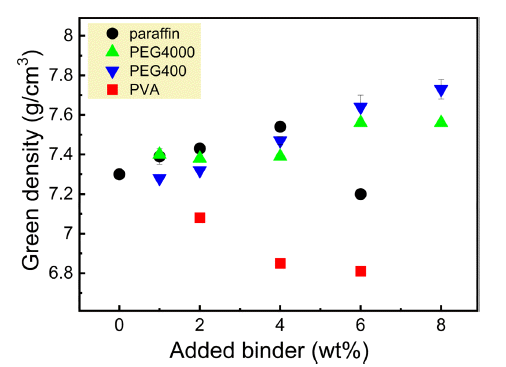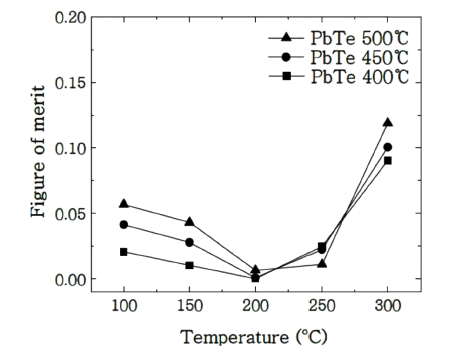Search
- Page Path
- HOME > Search
- [English]
- The Effect of SnO2 Addition on Sintering Behaviors in a Titanium Oxide-Copper Oxide System
- Ju-Won Lee, Kyung-Sik Oh, Tai-Joo Chung, Yeong-Kyeun Paek
- J Powder Mater. 2022;29(5):357-362. Published online October 1, 2022
- DOI: https://doi.org/10.4150/KPMI.2022.29.5.357

- 696 View
- 4 Download
-
 Abstract
Abstract
 PDF
PDF The low-temperature sinterability of TiO2-CuO systems was investigated using a solid solution of SnO2. Sample powders were prepared through conventional ball milling of mixed raw powders. With the SnO2 content, the compositions of the samples were Ti1-xSnxO2-CuO(2 wt.%) in the range of x ≤ 0.08. Compared with the samples without SnO2 addition, the densification was enhanced when the samples were sintered at 900°C. The dominant mass transport mechanism seemed to be grain-boundary diffusion during heat treatment at 900°C, where active grain-boundary diffusion was responsible for the improved densification. The rapid grain growth featured by activated sintering was also obstructed with the addition of SnO2. This suggested that both CuO as an activator and SnO2 dopant synergistically reduced the sintering temperature of TiO2.
- [Korean]
- Effect of Polymeric Binders on Green body Properties of WC-Co Cemented Carbides
- Young-Soo Lim, Sun-Yong Ahn, Jae-Suk Lim, Yeong-Kyeun Paek, Tai-Joo Chung
- J Powder Mater. 2022;29(4):291-296. Published online August 1, 2022
- DOI: https://doi.org/10.4150/KPMI.2022.29.4.291

- 409 View
- 3 Download
-
 Abstract
Abstract
 PDF
PDF The green body of WC-Co cemented carbides containing polymeric binders such as paraffin, polyethylene glycol (PEG), and polyvinyl acetate (PVA) are prepared. The green density of the WC-Co cemented carbides increases with the addition of binders, with the exception of PVA, which is known to be a polar polymeric substance. The green strength of the WC-Co cemented carbides improves with the addition of paraffin and a mixture of PEG400 and PEG4000. In contrast, the green strength of the WC-Co does not increase when PEG400 and PEG4000 is added individually. The compressive strength of the green body increases to 14 MPa, and the machinability of the green body improves when more than 4–6 wt% paraffin and a mixture of PEG400 and PEG4000 is used. Simultaneously, the sintered density of WC-Co is as high as 99% relative density, similar to a low binder addition of 1–2 wt%.
- [Korean]
- Mechanical Properties and Thermal Stability of Ti0.5Al0.5N/CrN Nano-multilayered Coatings
- Seung-Su Ahn, Jong-Keuk Park, Kyung-Sik Oh, Tai-Joo Chung
- J Korean Powder Metall Inst. 2020;27(5):406-413. Published online October 1, 2020
- DOI: https://doi.org/10.4150/KPMI.2020.27.5.406

- 442 View
- 2 Download
-
 Abstract
Abstract
 PDF
PDF Ti0.5Al0.5N/CrN nano-multilayers, which are known to exhibit excellent wear resistances, were prepared using the unbalanced magnetron sputter for various periods of 2–7 nm. Ti0.5Al0.5N and CrN comprised a cubic structure in a single layer with different lattice parameters; however, Ti0.5Al0.5N/CrN exhibited a cubic structure with the same lattice parameters that formed the superlattice in the nano-multilayers. The Ti0.5Al0.5/CrN multilayer with a period of 5.0 nm exceeded the hardness of the Ti0.5Al0.5N/CrN single layer, attaining a value of 36 GPa. According to the low-angle X-ray diffraction, the Ti0.5Al0.5N/CrN multilayer maintained its as-coated structure up to 700°C and exhibited a hardness of 32 GPa. The thickness of the oxidation layer of the Ti0.5Al0.5N/CrN multilayered coating was less than 25% of that of the single layers. Thus, the Ti0.5Al0.5N/CrN multilayered coating was superior in terms of hardness and oxidation resistance as compared to its constituent single layers.
- [Korean]
- Thermoelectric Properties of PbTe Prepared by Spark Plasma Sintering of Nano Powders
- Eun-Young Jun, Ho-Young Kim, Cham Kim, Kyung-Sik Oh, Tai-Joo Chung
- J Korean Powder Metall Inst. 2018;25(5):384-389. Published online October 1, 2018
- DOI: https://doi.org/10.4150/KPMI.2018.25.5.384

- 943 View
- 8 Download
- 2 Citations
-
 Abstract
Abstract
 PDF
PDF Nanoparticles of PbTe are prepared via chemical reaction of the equimolar aqueous solutions of Pb(CH3COO)2 and Te at 120°C. The size of the obtained particles is 100 nm after calcination in a hydrogen atmosphere. Dense specimens for the thermoelectric characterization are produced by spark plasma sintering of prepared powders at 400°C to 500°C under 80 MPa for 5 min. The relative densities of the prepared specimens reach approximately 97% and are identified as cubic based on X-ray diffraction analyses. The thermoelectric properties are evaluated between 100°C and 300°C via electrical conductivity, Seebeck coefficient, and thermal conductivity. Compared with PbTe ingot, the reduction of the thermal conductivities by more than 30% is verified via phonon scattering at the grain boundaries, which thus contributes to the increase in the figure of merit.
-
Citations
Citations to this article as recorded by- Improved Thermoelectric Performance of Cu3Sb1−x−ySnxInySe4 Permingeatites Double-Doped with Sn and In
Ho-Jeong Kim, Il-Ho Kim
Korean Journal of Metals and Materials.2023; 61(6): 422. CrossRef - Enhancing Electrical Properties of N-type Bismuth Telluride Alloys through Graphene Oxide Incorporation in Extrusion 3D Printing
Jinhee Bae, Seungki Jo, Kyung Tae Kim
journal of Korean Powder Metallurgy Institute.2023; 30(4): 318. CrossRef
- Improved Thermoelectric Performance of Cu3Sb1−x−ySnxInySe4 Permingeatites Double-Doped with Sn and In
- [Korean]
- A Study of the Sintering Behavior of Boron Carbide using In-situ High Temperature Dilatometer
- Hyukjae Lee, Bum-Sup Kim, Tai-Joo Chung
- J Korean Powder Metall Inst. 2014;21(2):102-107. Published online April 1, 2014
- DOI: https://doi.org/10.4150/KPMI.2014.21.2.102

- 711 View
- 4 Download
- 1 Citations
-
 Abstract
Abstract
 PDF
PDF A high temperature dilatometer attached to a graphite furnace is built and used to study the sintering behavior of B4C. Pristine and carbon doped B4C compacts are sintered at various soaking temperatures and their shrinkage profiles are detected simultaneously using the dilatometer. Carbon additions enhance the sinterability of B4C with sintering to more than 97% of the theoretical density, while pristine B4C compacts could not be sintered above 91% due to particle coarsening. The shrinkage profiles of B4C reveal that the effect of carbon on the sinterability of B4C can be seen mostly below 1950°C. The high temperature dilatometer delivers very useful information which is impossible to obtain with conventional furnaces.
-
Citations
Citations to this article as recorded by- Application of rate-controlled sintering into the study of sintering behavior of boron carbide
Hyukjae Lee
Journal of the Korean Crystal Growth and Crystal Technology.2015; 25(1): 6. CrossRef
- Application of rate-controlled sintering into the study of sintering behavior of boron carbide
- [Korean]
- Direct Observation on the Low Temperature Degradation Due to Surface Treatment in Y-TZP
- Tai-Joo Chung, Hye-Sung Kim
- J Korean Powder Metall Inst. 2010;17(3):197-202.
- DOI: https://doi.org/10.4150/KPMI.2010.17.3.197

- 550 View
- 2 Download
-
 Abstract
Abstract
 PDF
PDF - Low temperature degradation behavior in yttria stabilized tetragonal zirconia polycrystal (Y-TZP) ceramics was microscopically observed from the phase contrast between monoclinic surface and tetragonal matrix. The degradation behavior was dependent on the surface treatment of sintered Y-TZP, even if the sintering history is same. In the mirror polished specimen, the monoclinic layer appeared in a uniform thickness from the surface. On the contrary, for the specimen with coarse scratch, the thickness of degraded surface was more than double especially from the coarse scratch. Since the scratch results in local deformation, the residual stress should be induced around the scratch. With the transformation from tetragonal to monoclinic, the volume expansion exerts a stress on a neighboring grains and promotes a successive phase transformation. Such a autocatalytic effect can be triggered from the part of coarse scratch.
- [Korean]
- Microstructural Evolution and Properties in Ti(CN)-Co/Ni Cermet Depending on the Starting Material for Incorporation of WC
- Tai-Joo Chung, Sun-Yong Ahn, Seung-Su Ahn, Myung-Soo Shin, Hak-Kyu Kim, Kyung-Bae Kim, Kyung-Sik Oh, Hyuk-Jae Lee
- J Korean Powder Metall Inst. 2007;14(2):132-139.
- DOI: https://doi.org/10.4150/KPMI.2007.14.2.132

- 726 View
- 2 Download
- 1 Citations
-
 Abstract
Abstract
 PDF
PDF - In the Ti(CN)-Co/Ni cermet, WC is an effective additive for increasing sinterability and mechanical properties such as toughness and hardness. In this work, WC, (WTi)C and (WTi)(CN) were used as the source of WC and their effects were investigated in the respect of microstructural evolution and mechanical properties. Regardless of the kinds of WC sources, the hard phase with dark core and bright rim structure was observed in the Ti(CN)-Co/Ni cermet under the incorporation of relatively small amount of WC. However, hard phases with bright core began to appear and their frequency increased with the increase of all kinds of WC source addition. The ratio of bright core to dark one in the (TiW)(CN)-Co/Ni cermet was greatest under the incorporation of (WTi)C compared at the same equivalent amount of WC. The mechanical properties were improved with the addition of WC irrespective of the kinds of sources, but the addition of (WTi)(CN) was less effective for the increase of fracture toughness.
-
Citations
Citations to this article as recorded by- Investigation into the microstructure and cutting performance of (Ti,Ta,W)(CN)–Co/Ni cermets
Se-Woong Oh, Sun-Yong Ahn, Kyung-Sik Oh, Hyukjae Lee, Tai-Joo Chung
International Journal of Refractory Metals and Hard Materials.2015; 53: 36. CrossRef
- Investigation into the microstructure and cutting performance of (Ti,Ta,W)(CN)–Co/Ni cermets
- [Korean]
- Effect of Grain Size and Heat-treating Atmosphere on the Phase Stability of Y-TZP
- Tai-Joo Chung, Seung-Su Ahn, Eun-Wha Song, Kyung-Sik Oh, Jong-Sook Lee, Young-Sik Kim
- J Korean Powder Metall Inst. 2006;13(5):360-365.
- DOI: https://doi.org/10.4150/KPMI.2006.13.5.360

- 690 View
- 1 Download
- 1 Citations
-
 Abstract
Abstract
 PDF
PDF - The phase stability of tetragonal phase in Y-TZP was investigated in terms of the distribution of grain sizes and heat-treating atmosphere. Y-TZP with various grain sizes were prepared using duration time at 1600°C as experimental parameter. Accumulated grain size distributions were built from the SEM micrographs and the amount of tetragonal phase were measured using XRD. Both results were compared to determine the critical grain size before and after heat-treatment in vacuum. The critical grain size drastically decreased compared with the small increase of average grain size due to the autocatalytic effect which critically affects the tetragonal to monoclinic phase transformation. After heat-treatment in reductive atmosphere critical grain size relatively increased due to the stabilization of tetragonal phase. The formation of oxygen vacancies during heat-treatment was ascribed to the increase of stability.
-
Citations
Citations to this article as recorded by- Direct Observation on the Low Temperature Degradation Due to Surface Treatment in Y-TZP
Tai-Joo Chung, Hye-Sung Kim
Journal of Korean Powder Metallurgy Institute.2010; 17(3): 197. CrossRef
- Direct Observation on the Low Temperature Degradation Due to Surface Treatment in Y-TZP
TOP
 KPMI
KPMI


 First
First Prev
Prev


